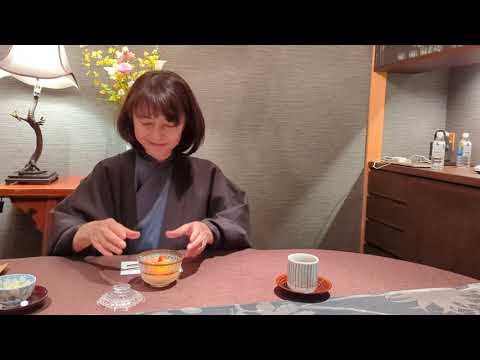This was the second of two dinners that we had served in our room while staying at Kakunodate Sanso Wabizakura ryokan (角館山荘 侘桜), a luxury boutique Onsen (natural thermal hot springs) ryokan (inn) with just 10 rooms total. All meals were served in our own room (which has a private dining room.) We were mighty impressed with the previous evening’s meal, but this one was equally amazing. This definitely ranks among the finest ryokan meals we’ve ever had. The menu as well as explanation of each serving was in Japanese, but I’ve tried my best to summarize it here, in both languages. They are:
COURSE 1 – Zatsuki (座附 – Appetizer):
* Komochi Konbu (子持ち昆布 – Kazunoko Herrings that laid its eggs on Konbu Sea Kelp)
– Haru Bitashi (春浸し – Spring Vegetables in Cold Dashi Broth):
– Yama Udo (山独活 – Wild Mountain Japanese Spikenard/Aralia Cordata)
– Warabi (蕨 – Bracken)
– Fuki (蕗の薹 – Butterbur)
– Hamaboufu (浜防風 – Hamabofu is a wild blanched Japanese plant that grows along the coast)
– Himekawa Takenoko (姫皮筍 – The thin, soft membrane inside the tip of a Bamboo Shoot)
– Chigusa Ooba (千草大葉 – Perilla)
– Katsura Shoga (桂生姜 – Katsura Ginger)
COURSE 2 – Zensai (前菜 – Appetizer #2):
* Sumi-ika Shutou-ae (墨烏賊酒盗和え – Golden Spineless Cuttlefish with Fermented Fish Guts)
* Kaibashira to Amaebi Tenmame/Soramame Hana Wasabi Jule-kake (貝柱甘海老天豆花山葵ジュレ掛け – Scallops & Sweet Shrimp with Broad Bean, and Wasabi Flower Jelly)
* Taranome Tempura (タラの芽天ぷら – Japanese Angelica Tree Sprouts Tempura)
* Chiayu Mijinko Age (稚鮎微塵粉揚げ – Baby Sweetfish Tempura fried in Mijin rice flour powder)
* Hon Masu Kinome Yaki (本鱒木の芽焼き – Hon Masu Salmon fried with the Young leaves of a Sansho Plant. Hon Masu is a Salmon caught in the Sea of Japan between March and May)
* Yama Momo Mitsu-ni (山桃蜜煮 – Japanese Bayberry with Syrup)
* Nidako to Shin Tamanegi Basil Sauce-kake (煮蛸新玉葱バジルソース掛け – Simmered Octopus and New Onions with Basil Sauce)
* Shidoke Egoma Miso-kake (しどけ荏胡麻味噌掛け – Shidoke with Beefsteak Plant & Fermented Miso Soybean Paste Sauce. Shidoke is a wild mountain vegetable found in Japan. Beefsteak Plant is somewhat similar to a Perilla)
* Koshiabura Kasumi-age (こしあぶら霞揚げ – Koshiabura fried in ground rice crackers. Koshiabura is a wild mountain vegetable found in Japan)
COURSE 3 – Otsukuri (御造り – Sashimi):
* Madai Kobujime (真鯛昆布〆 – Konbu Sea Kelp-cured Japanese Sea Bream)
* Hirame Negi Maki (鮃 – Flounder/Sole/Flat Fish wrapped over Green Onions)
* Hirame Engawa (鮃縁側 – Flounder/Sole/Flat Fish’s muscle used for moving its fins)
* Yuba Konyaku (湯葉蒟蒻 – Yuba Tofu Skin mixed with Konjac)
COURSE 4 – Yakimono (焼物 – Grilled Dish):
FOR HIM:
* Akita Gyu Miso Yuan-yaki (秋田牛味噌幽庵焼き – Akita Beef marinated with Fermented Miso Soybean Paste and a mixture of soy sauce, sake, sugar, mirin and citrus fruit)
– Haru Kyabetsu (春キャベツ – Spring Cabbage)
– Kogomi (こごみ – Ostrich Fern)
– Shinjaga (新じゃが – New Potatoes)
– Kabu (蕪 – Japanese Turnip)
– Nagaimo (長芋 – Chinese Yam / Japanese Mountain Yam)
– Hatsuka Daikon (二十日大根 – Early Maturing Japanese Daikon Radish)
– Gyoja Ninniku (行者大蒜 – Siberian Onion)
– Yuzu Kosho (柚子胡椒 – Yuzu Citrus and Pepper Paste)
– Tonyu Goma-dare (豆乳胡麻だれ – Soy Milk and Sesame Sauce)
FOR HER:
* Sawara no Yakimono (鰆の焼き物 – Grilled Japanese Spanish Mackerel)
* Kinki no Ichiyaboshi (キンキの一夜干し – Overnight-dried (not sun-dried) Channel Rockfish)
COURSE 5 – Shiizakana (強肴 – Large, Hot Dish):
* Haru no Sankai Kaori Nabe (春の山海香り鍋)
– Hamaguri (蛤 – Common Hard Clam)
– Oasari-gai (大浅利貝 – Purple Butter Clam)
– Kinmedai (金目鯛 – Splendid Alfonso)
– Nama Shirauo (生白魚 – Raw Ice Fish)
– Urui (うるい – Hostas)
– Shin Takenoko (新筍 – New Bamboo Shoots)
– Shin Wakame (新若布 – New Wakame Seaweed)
– Shiraga Negi (白髪葱 – Thin, long Green Onion Strips)
– Jiku Mitsuba (軸三つ葉 – Japanese Wild Parsley)
– Hari Shoga (針生姜 – Ginger that is finely chopped like a needle)
– Kinome (木の芽 – Young Leaves of a Sansho Plant)
COURSE 6 – Oshokuji (御食事 – Rice Dish):
* Seiro Gohan (蒸籠御飯 – Rice Steamed in a Bamboo Steamer)
– Usui Mame (うすい豆 – Wakayama Pea Bean)
– Murasaki Shio (紫塩 – Purple Himalayan Rock Salt)
* Tomewan (留め椀 – Soup Dish)
– Akadashi (赤出汁 – Fermented Red Soybean Paste Soup)
* Kounomono (香の物 – Pickled Vegetables)
– Iburi Daikon (いぶり大根 – Smoked & Pickled Daikon Radish)
– Daikon Nappa (大根の葉っぱ – Daikon Radish Leaves)
– Kyuri (胡瓜 – Cucumber)
– Ninjin (人参 – Carrots)
COURSE 7 – Mizugashi (水菓子 – Fruit-based Dessert):
* Tonyu Pudding to Kuromitsu (豆乳プリンと黒蜜 – Soy Milk Pudding with Japanese Brown Sugar Syrup)
– Suika (西瓜 – Watermelon)
– Ichigo (苺 – Strawberries)
– Shine Muscat (シャインマスカット – Shine Muscat Grape)
– Orange (オレンジ)
– Blueberry (ブルーベリー)


AloJapan.com